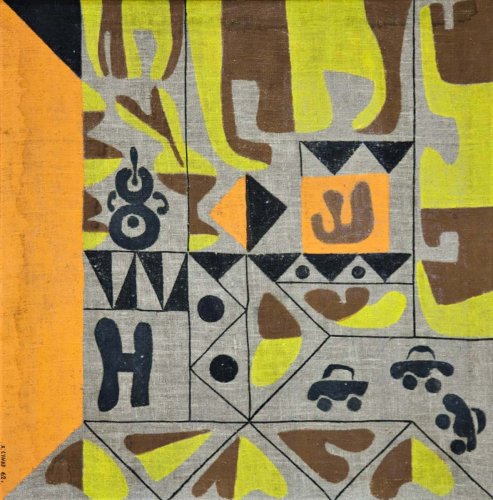Anatoliy Sumar. Street (1962)
The author of the painting, Anatoliy Sumar (1933-2006), lived and worked in Kyiv from 1948 to 2006. He wrote most of his paintings in the period from 1957 to 1964. An architect by education, Sumar did not consider himself a professional artist, but this is what allowed him to be creative, regardless of the official socialist realist canon. Instead, he relied on the European avant-garde of the beginning of the 20th century (which he could see in the museums of Moscow and St. Petersburg, because the works of the Ukrainian avant-garde, hidden in special funds or destroyed, were not available to him). This avant-garde did not go unnoticed — Sumar was criticized as a formalist and an abstractionist, after which he stopped writing for many years. The artist's work was discovered only in the 90s of the last century.
Anatoliy Sumar. Street (1962)
The painting Street, or as it is also called, Golden Gate Square, belongs to the most fruitful period of Anatoliy Sumar's work. At that time, the artist, together with his wife, Asta Pekker, lived and worked in a house on Volodymyrska Street, opposite the Opera House. Thanks to his wife, a special atmosphere reigns in the apartment: a kind of salon is formed (a group of like-minded people who gathered in a private room and had conversations on a chosen topic. The most famous were the French salons of the 17th and 18th centuries, which clustered around famous female patrons). Sumar's extraordinary sensitivity to the streets and boulevards of Kyiv (as well as Lviv, Yalta, and small Crimean towns), terraces, windows, and interiors can be explained by his education as an architect, for which, in fact, he never received a diploma.
The artist's works are often called abstract, however, reality is very clearly visible in them. In Zolotovoritskyi Square, for example, the street and cars shown at the bottom right are perfectly legible. A feature of this work is also the fact that the artist uses an unprimed canvas of light brown color. The artist repeatedly resorts to this technique in his late works of the 1990s. Interestingly, in the 2000s, Anatoliy Sumar created an updated version of the work, Zolotovoritsky Square-2. Specialists call it a digital analogue because of its special shape and bright, somewhat neon, color scheme, which is atypical for the artist.
Street by Anatoliy Sumar was animated by Pause to Play animation studio.
Created as part of the Living Collection project
The painting Street, or as it is also called, Golden Gate Square, belongs to the most fruitful period of Anatoliy Sumar's work. At that time, the artist, together with his wife, Asta Pekker, lived and worked in a house on Volodymyrska Street, opposite the Opera House. Thanks to his wife, a special atmosphere reigns in the apartment: a kind of salon is formed (a group of like-minded people who gathered in a private room and had conversations on a chosen topic. The most famous were the French salons of the 17th and 18th centuries, which clustered around famous female patrons). Sumar's extraordinary sensitivity to the streets and boulevards of Kyiv (as well as Lviv, Yalta, and small Crimean towns), terraces, windows, and interiors can be explained by his education as an architect, for which, in fact, he never received a diploma.
The artist's works are often called abstract, however, reality is very clearly visible in them. In Zolotovoritskyi Square, for example, the street and cars shown at the bottom right are perfectly legible. A feature of this work is also the fact that the artist uses an unprimed canvas of light brown color. The artist repeatedly resorts to this technique in his late works of the 1990s. Interestingly, in the 2000s, Anatoliy Sumar created an updated version of the work, Zolotovoritsky Square-2. Specialists call it a digital analogue because of its special shape and bright, somewhat neon, color scheme, which is atypical for the artist.
Series Color and Music:
Due to powerful criticism and a long-term break in work, researchers knew almost nothing about the series of works Color and Music. Sumar tried to translate musical works into the language of painting. In the works of the series, he subordinated the compositional structure of the work to the musical composition. Unfortunately, we do not know exactly which musical works the artist translated into the visual dimension (according to his wife, they were Bach's fugues), because the key to reading them has been lost. On the one hand, the works are a pure painting form, on the other — one cannot forget about their musical component. The skill of the artist is also emphasized by purely technical points: some color schemes count up to 110 segments that maintain their rhythm and convey the mood. An interesting unanswered question is whether Anatoliy Sumar knew about similar experiments by Kyiv architect Florian Yuriev and his attempts to combine light, color and music in one room.
Anatoliy Sumar as a modern hermit:
In academic articles, Sumar is often called a hermit. Despite the fact that the artist's wife worked as an editor of the publishing house Naukova dumka (Scientific Thought) and invited many interesting people to their house — for example, the couple communicated with artists Tetiana Yablonska, Ada Rybachuk, Volodymyr Melnychenko — Anatoliy Sumar, according to the memories of those around him, was a very closed person, a recluse. It was this alienation that simultaneously became a guarantee of individual freedom and required severe criticism not only of oneself, but also of the environment.
